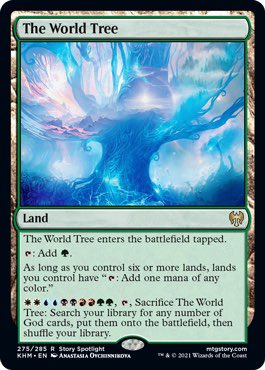When Theros Beyond Death released a little over a year ago I was ecstatic that there were finally enough Enchantment Gods printed to build a commander deck around. I was first pulled in by the flavour, but after a few iterations I landed on a build that could jettison my deck into play - leading to many memorable stories. Of course this is achievable with Enter the Infinite + Omniscience, but that would just be too easy. The current version of this list leverages cost reduction, Enchantresses, and Morophon, the Boundless to cast Enchantment Gods for free and draw our deck. It was built with the intent to play at a 7 in terms of power level, so there is limited recursion and interaction. The majority of combo pieces are creatures, making the deck easily answered and susceptible to wrath-heavy tables. Kaldheim introduced some new toys for this deck so let’s dive in and see what changes we can make.
Before we get to the new hotness, a quick overview of the structure. You can find the entire deck list below or on Archidekt, but the main line we want to get to is cost reduction at three CMC (or more), three Enchantress effects (two isn’t enough and with four you’ll self-mill), and coloured mana cost reduction. Finding ways to increase redundancy in our singleton format is key, and we luckily have a lot of options for our parts. In terms of Enchantress draw effects, we have nine total; including some obvious picks like Argothian Enchantress, Reki History of Kamigawa, and Jhoira, Weatherlight Captain.


Earlier I mentioned getting cost reduction to three was the magic number, and this is driven by the fact that 22 of the 25 included Gods become free casts at that point. With twelve targets, getting two or three in play shouldn’t be too difficult. Most of the cost reduction effects hit all the Gods, but with a few non-Enchantment Gods from Amonkhet, Starfield Mystic and Herald of the Pantheon will be whiffs. We then move to colored cost reduction which we have in the command zone with Morophon. The ideal scenario would be to have Morophon in play with Fist of Suns, but we can efficiently reduce costs with Heartless Summoning and Urza’s Incubator. Personally, when I’m building redundancy into my commander decks, I like to aim for fifteen targets. Without getting into it too deep, fifteen cards of a ninety nine card deck translates to having at least one of those fifteen cards in your opening hand ~seventy percent of the time.

With our primary strategy being cheating the Gods into play, some sacrifices needed to be made in construction. This deck foregoes almost all removal with the exception of Urza’s Ruinous Blast and only relies on Kethis, the Hidden Hand for recursion (with mostly Indestructible Gods, we shouldn’t need to recur them often). We run four God-focused tutors and we have a decent amount of ramp and fixing with eleven permanents that help us get our colours sorted (Land Tax) or expedite our game plan (Smothering Tithe). For additional draw effects, we benefit our opponents a bit with some group hug style Enchantments. The last category of cards we have relates to Devotion, an important piece to make sure our Gods can become creatures. Most of our ramp and fixing package contributes to devotion by using Altar of the Pantheon and the borderposts, but Spiteful Visions and Dictate of Kruphix help round out the under supported colours.

So how does this deck win? Once the engine is set up, we can churn through our deck and chain free-cast Gods with the hopes of digging into Phenax, God of Deception and Purphoros, Bronze Blooded. With these two in play and the rest of the pantheon we can effectively mill the table for 143 which can sufficiently close a late game, and if it’s still early we can drop a Heroes’ Podium to ratchet that up to 793 in a best-case scenario. In reality, Purphoros, Phenax, Morophon and 10 other Gods will close out a game that’s past turn five with the podium (milling for ~260). There are a few backup strategies in case our engine is dismantled or Phenax makes his way to exile. Attacking while Nylea, God of the Hunt is in play, making a swarm of Insects off of The Locust God or using Thassa, God of the Sea’s activated ability can get us a combat centric win. If we’re behind and have access to mana, we can always try to resolve Kamahl’s Druidic Vow to cheat some Gods in the old fashioned way.


Now that you have a good sense of how this machine runs, let’s turn our eyes to Kaldheim and see which tweaks are worth making. Of course, there are twelve new Gods in Kaldheim which increases our options up to forty seven total Gods to choose from. While I think the Kaldheim MDFC Gods are a great design space, I think only one of them suits our purpose: Esika, God of the Tree. A 5-colour enchantment that counts towards Devotion and lets us cheat more Gods into play, or as a solid ramp option transforming our Legendary creatures into Birds of Paradise; Esika is sure to be an exceptional addition. Beyond the new Gods, the other cards from Kaldheim we should consider including are Starnheim Courser and The World Tree. The Courser would give us another cost reduction effect, so it may be a good time to review our Enchantress effects as well and consider increasing redundancy in both categories. Some “Enchantress” effects we could consider are Guardian Project, Beast Whisperer, and Song of Creation. Lastly, “Put any number of Gods onto the battlefield” is exactly what this deck is all about, so we need to find a spot for The World Tree. It will garner a lot of attention when it’s played, but it gives us another good plan B in this list. You could shortcut all of the engine building by switching the commander to Golos, Tireless Pilgrim and running mana doublers (such as Dictate of Karametra) alongside recursion like Crucible of Worlds, but that approach may be too consistent for mid-powered tables. I think making room for these six cards would increase consistency so we can “do the thing”, so let’s take a look at what our first cuts should be.



Finding six cards to cut from a deck that’s been together for a while can be hard, but the first place we can look is for specific cards that don’t directly contribute to our main game plan. While Kamahl’s Druidic Vow can provide some form of oomph, it may not be consistent enough, and relative to The World Tree it pales in comparison. This deck runs a low land count of 35, and we should aim to keep it there. Who needs mana when your spells are free, right? I think in terms of mana base, dropping Prismatic Vista is safest since we only have ten targets that will be tutored with Land Tax anyways. The next cut I’d consider is Enchanted Evening. The 5-mana enchantment extends our Enchantress effects to all of our permanents and the hybrid mana does double duty for Devotion, but it definitely fits in the win more category, making it a dead card in some situations. To tighten our list further we can consider replacing some of our generic draw effects with our new on-strategy ones. Stormfist Crusader is an easy cut, and the next I’d consider from this category is Dictate of Kruphix. Dictate is a tough one though as it will further reduce our blue Devotion down to twelve. I think Dictate is the right cut for now though, given it will also reduce the amount of answers our opponents have. With all of these in mind, that leaves one more cut to make. I’m tempted to drop Sisay, Weatherlight Captain, but she can pull out either Kethis or Reki which gets a cost reduction or Enchantress into play. While not ideal, I think the best cut given what’s left would be Urza’s Ruinous Blast. Sure the wrath wipes our opponents’ boards, but costing five CMC is quite pricey in a list that’s all about casting free spells.

Here’s the new list, with all it’s God-infused glory. All-in-all, our new category counts break down more favourably for our main game plan, getting our cost reduction and Enchantress categories closer to the target of fifteen. With only one wrath in our first version it was pretty unlikely we’d have it when we needed it, but now we have zero interaction. This will lead to some games where we don’t contribute much, but the ones where we do will be Legendary. Either way, I’m excited to try out the new additions from Kaldheim and see how many times I can sacrifice The World Tree to assemble the pantheon. What changes would you have made? Do you agree with my cuts? Anything that’s not in here that should be? Let me know in the comments below or reach out to me on Twitter. If that’s not your jam you can find me in the #commander channel of the Chimera Discord (which you should join if you haven’t yet).






